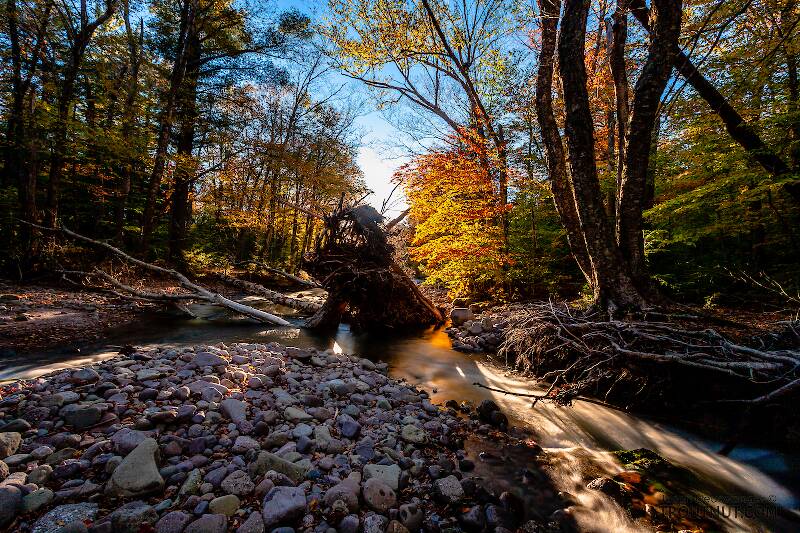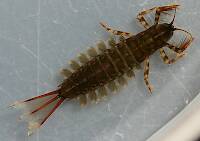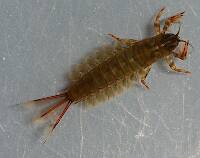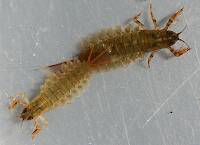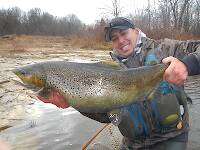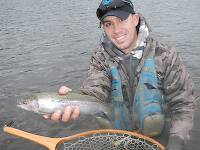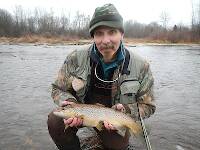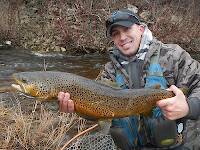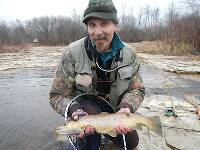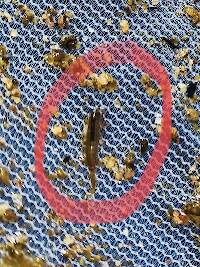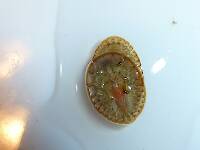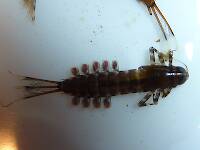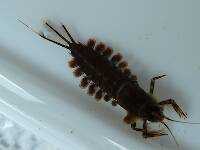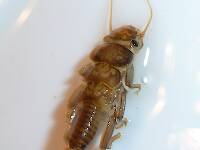
Salmonflies
Pteronarcys californica
The giant Salmonflies of the Western mountains are legendary for their proclivity to elicit consistent dry-fly action and ferocious strikes.
Featured on the forum

Nymphs of this species were fairly common in late-winter kick net samples from the upper Yakima River. Although I could not find a key to species of Zapada nymphs, a revision of the Nemouridae family by Baumann (1975) includes the following helpful sentence: "2 cervical gills on each side of midline, 1 arising inside and 1 outside of lateral cervical sclerites, usually single and elongate, sometimes constricted but with 3 or 4 branches arising beyond gill base in Zapada cinctipes." This specimen clearly has the branches and is within the range of that species.

Troutnut is a project started in 2003 by salmonid ecologist Jason "Troutnut" Neuswanger to help anglers and
fly tyers unabashedly embrace the entomological side of the sport. Learn more about Troutnut or
support the project for an enhanced experience here.
Troutnut on Jun 14, 2006June 14th, 2006, 10:02 am EDT
While reading though fly fishing entomology books to put together all the species writeups, I've noticed that several authors write about many mayfly species migrating toward shore in preparation for emergence. They describe this phenomenon both for hatches that emerge on the surface and for those that crawl out on land. The suggested manner of imitation is often to fish a nymph on the swing from the center of the river up into the shallows.
Here's a typical example, from Fred Arbona's excellent book Mayflies, the Angler, and the Trout:
And, so as not to single out one author, here's a piece from the Stenonema ithaca page of Hatches II:
I'm very skeptical of these ideas.
For one thing, I've never seen a mayfly species emerge preferentially near the bank. Many prefer specific substrates or depths, but these things are rarely concentrated right next to shore. The tails of pools, eddies, shallow flats, and other habitats provide the same sort of easy swimming.
Also, "migrate" is a strange word for it. Nymphs may not be as fast as trout, but they can move at a respectable clip, and I can't see it taking them weeks or even days to go from the middle of a stream to the side. I think an Isonychia nymph could do it in under a minute in most rivers. It's like "migrating" from your bedroom to your kitchen when you wake up. Nymphs might take more time and stop at every rock along the way to rest, but such a punctuated migration is hardly what the books bring to mind.
Even if nymphs migrate exactly as suggested, I very much doubt that it happens in such concentrated numberas as dun emergences or spinner falls. It is surely a more gradual event, and there are surely individual nymphs in all different stages of the "migration" and not just along the shore. I doubt there is enough of an increase in nymphs along the shore to warrant a trout takin the extra risks involved in shallow water.
I think it would take some serious observation (like LaFontaine did with his scuba gear) to verify that trout "follow" a mass migration of nymphs toward shore to feed on them. I've not heard of any such observations for this phenomenon. Has anyone else?
My guess would be that somebody thought up this idea and other writers have just echoed it for years. They probably fished nymphs in the manner suggested, caught fish, and considered the hypothesis proven. My guess is that the nymphs do get more active and these people caught fish because of that, and not because of the exact manner of imitation. People may also catch trout feeding along the banks for various other reasons.
Anyone else have a hard time swallowing this conventional wisdom?
Here's a typical example, from Fred Arbona's excellent book Mayflies, the Angler, and the Trout:
The naturals of Isonychia and Siphlonurus nymphs are perpetually on a mini-exodus toward the bank during the summer months, and anglers aware of this biology stand to do well with opportunistic trout capitalizing on nymphal migration.
And, so as not to single out one author, here's a piece from the Stenonema ithaca page of Hatches II:
Prior to emergence, fish nymph patterns deep with occasional twitches to simulate the migratory crawling habits of the naturals.
I'm very skeptical of these ideas.
For one thing, I've never seen a mayfly species emerge preferentially near the bank. Many prefer specific substrates or depths, but these things are rarely concentrated right next to shore. The tails of pools, eddies, shallow flats, and other habitats provide the same sort of easy swimming.
Also, "migrate" is a strange word for it. Nymphs may not be as fast as trout, but they can move at a respectable clip, and I can't see it taking them weeks or even days to go from the middle of a stream to the side. I think an Isonychia nymph could do it in under a minute in most rivers. It's like "migrating" from your bedroom to your kitchen when you wake up. Nymphs might take more time and stop at every rock along the way to rest, but such a punctuated migration is hardly what the books bring to mind.
Even if nymphs migrate exactly as suggested, I very much doubt that it happens in such concentrated numberas as dun emergences or spinner falls. It is surely a more gradual event, and there are surely individual nymphs in all different stages of the "migration" and not just along the shore. I doubt there is enough of an increase in nymphs along the shore to warrant a trout takin the extra risks involved in shallow water.
I think it would take some serious observation (like LaFontaine did with his scuba gear) to verify that trout "follow" a mass migration of nymphs toward shore to feed on them. I've not heard of any such observations for this phenomenon. Has anyone else?
My guess would be that somebody thought up this idea and other writers have just echoed it for years. They probably fished nymphs in the manner suggested, caught fish, and considered the hypothesis proven. My guess is that the nymphs do get more active and these people caught fish because of that, and not because of the exact manner of imitation. People may also catch trout feeding along the banks for various other reasons.
Anyone else have a hard time swallowing this conventional wisdom?
Jason Neuswanger, Ph.D.
Troutnut and salmonid ecologist
Troutnut and salmonid ecologist
Shawnny3 on Jul 16, 2006July 16th, 2006, 4:26 pm EDT
I'm also skeptical of this idea, but I'm skeptical about almost every idea, so that in itself means very little.
One thing that is certain is that fish holding in slow-moving water, whether it be near the bank or behind a protruding rock in the middle of the stream, will often strike with alacrity at a nymph stripped into their window, even when the nymph is stripped at speeds no natural nymph has ever acheived. Both when fish are resting peacefully and when they are feeding aggressively, fly movement can a powerful trigger (albeit an inconsistent one). When fishermen swinging wets think they are mimicking authentic emergent behavior, they really may be doing nothing more than triggering fish in slow water to react aggressively on a moving object.
A vivid anecdote to deceive readers into agreeing with my generalizations: My brother and I were once fishing in the dead of winter with sowbugs and shrimp. My brother spotted a fish rise fifty feet away to a midge in completely dead water. Instead of going through the hopeless excerise of switching leaders and flies and trying to make one perfect cast to one rising fish, he threw his size-16 sowbug (a foot behind some split shot, mind you) a few feet upstream of the fish and stripped it hard. Of course, I wouldn't be telling the story if the fish hadn't hammered that sowbug.
-Shawn
One thing that is certain is that fish holding in slow-moving water, whether it be near the bank or behind a protruding rock in the middle of the stream, will often strike with alacrity at a nymph stripped into their window, even when the nymph is stripped at speeds no natural nymph has ever acheived. Both when fish are resting peacefully and when they are feeding aggressively, fly movement can a powerful trigger (albeit an inconsistent one). When fishermen swinging wets think they are mimicking authentic emergent behavior, they really may be doing nothing more than triggering fish in slow water to react aggressively on a moving object.
A vivid anecdote to deceive readers into agreeing with my generalizations: My brother and I were once fishing in the dead of winter with sowbugs and shrimp. My brother spotted a fish rise fifty feet away to a midge in completely dead water. Instead of going through the hopeless excerise of switching leaders and flies and trying to make one perfect cast to one rising fish, he threw his size-16 sowbug (a foot behind some split shot, mind you) a few feet upstream of the fish and stripped it hard. Of course, I wouldn't be telling the story if the fish hadn't hammered that sowbug.
-Shawn
Jewelry-Quality Artistic Salmon Flies, by Shawn Davis
www.davisflydesigns.com
www.davisflydesigns.com
Troutnut on Jul 16, 2006July 16th, 2006, 6:33 pm EDT
Have you read Gary LaFontaine's The Dry Fly: New Angles?
It's one of the best fly fishing books I've ever read. LaFontaine developed the beginnings of a "theory of attraction" to figure out which features trigger the trout's predatory instincts. He categorized traits into those which grab the trout's attention from afar and those which calm its suspicions up close. He believed that the ideal fly will be more attractive to the trout than a real insect, because it should be able to exaggerate the right characteristics without drawing suspicion. We are all far from meeting that theoretical ideal, but his book is the first step in that direction.
Motion is one of the attracting traits.
Since I read that book I swung back toward fishing a lot of attractor patterns. I love hatch-matching, as anybody who's browsed through this site can see, but it has its time and place: a hatch. A lot of anglers (and I've been guilty of this in the past) find themselves tying on a pattern to match the one lonely mayfly they've seen in the last hour. I think the sub-conscious rationale is that if the fish aren't being picky then anything will work, so our hatch-matching tendency guides our otherwise random fly selection. It's a little bit senseless, because the fly does matter during non-hatch periods, and few realistic patterns can draw an unselective trout from as far away as an attractor -- especially one fished with some motion.
I like your anecdote. I almost never change to a hatch-matching fly before casting to a fish unless I'm positive I know what it's rising to and that it's rising steadily. In that case I want my first shot to be my best shot. But if there's any chance the fish isn't selective, I throw whatever I've got on. There are better things to do with those 30 seconds than making an unnecessary fly change.
It's one of the best fly fishing books I've ever read. LaFontaine developed the beginnings of a "theory of attraction" to figure out which features trigger the trout's predatory instincts. He categorized traits into those which grab the trout's attention from afar and those which calm its suspicions up close. He believed that the ideal fly will be more attractive to the trout than a real insect, because it should be able to exaggerate the right characteristics without drawing suspicion. We are all far from meeting that theoretical ideal, but his book is the first step in that direction.
Motion is one of the attracting traits.
Since I read that book I swung back toward fishing a lot of attractor patterns. I love hatch-matching, as anybody who's browsed through this site can see, but it has its time and place: a hatch. A lot of anglers (and I've been guilty of this in the past) find themselves tying on a pattern to match the one lonely mayfly they've seen in the last hour. I think the sub-conscious rationale is that if the fish aren't being picky then anything will work, so our hatch-matching tendency guides our otherwise random fly selection. It's a little bit senseless, because the fly does matter during non-hatch periods, and few realistic patterns can draw an unselective trout from as far away as an attractor -- especially one fished with some motion.
I like your anecdote. I almost never change to a hatch-matching fly before casting to a fish unless I'm positive I know what it's rising to and that it's rising steadily. In that case I want my first shot to be my best shot. But if there's any chance the fish isn't selective, I throw whatever I've got on. There are better things to do with those 30 seconds than making an unnecessary fly change.
Jason Neuswanger, Ph.D.
Troutnut and salmonid ecologist
Troutnut and salmonid ecologist
Wiflyfisher on Jul 18, 2006July 18th, 2006, 12:33 pm EDT
If you think of all the debris that constantly passes through a trout's window of vision there has to be certain triggers that help a fish decide what is food and what is not food. Afterall, if they wasted all their time chasing non-food items they would soon be starving to death. Some sort of motion, not matter how small, has to be one of the major triggers to a hungry, selective trout. At the same time, some unnatural movements may cause trout to be more wary and put them down, especially in low, clear water.
I have read several times Gary felt a "hot spot" on dry flies provided "triggers" that help provoke trout to strike.
John S.
I have read several times Gary felt a "hot spot" on dry flies provided "triggers" that help provoke trout to strike.
John S.
John S.
https://WiFlyFisher.com
https://WiFlyFisher.com
Ewp on Jul 30, 2006July 30th, 2006, 2:09 am EDT
I've seen the Siphlonorus nymphs concentrated in very high densities near the shore on the W. Branch of the Delaware duirng thier hatching season. I have always believed this to be an action prior to hatching as it apparently is in some rivers with Isonychia. That said, I have also seen serious emergences of Isonychia (have no idea what species) in mid river on the Hiwassee in Tennessee. I also have observed very high concerntration of Iso shucks on rocks near shore in northeastern rivers. Whether they "all" emerge near shore is beyond my ability to determine given the high densities of simultaneous emergences of other species that occur during most Iso hatches I've seen.
When I fished the Beaverkill regularly, an Isonychia nymph was one of my fail-safe flies. I believed then that there was a tendency for the Iso nymphs to change their location in the river in response to changing angles of sunlight. The Beaverkill flows primarily from east to West, and it was my practice to nymph fish certain runs (tail of Hendricksons pool, Horse Brook Run) with a concentration on the shaded side of the boulders. Whether it made biological sense is open to question. I know from a productivity standpoint, it made fishing sense, but Lord knows there is a ton of variables here.
As to speed, you estimate a minute for an Isonychia nymph to go from center stream to shore. Maybe on the Mississippi. Those I've observed on the Beaverkill could do it in ten seconds; i.e., faster than a black-nosed dace, for example. My experience fishing the nymph has been that while dead drift is effective, it also can't be fished "too fast" -- too fast to support the tippet during a strike perhaps, but not so fast that it is not imitating the natural.
Just a couple observations from a "pragmatist."
ewp
When I fished the Beaverkill regularly, an Isonychia nymph was one of my fail-safe flies. I believed then that there was a tendency for the Iso nymphs to change their location in the river in response to changing angles of sunlight. The Beaverkill flows primarily from east to West, and it was my practice to nymph fish certain runs (tail of Hendricksons pool, Horse Brook Run) with a concentration on the shaded side of the boulders. Whether it made biological sense is open to question. I know from a productivity standpoint, it made fishing sense, but Lord knows there is a ton of variables here.
As to speed, you estimate a minute for an Isonychia nymph to go from center stream to shore. Maybe on the Mississippi. Those I've observed on the Beaverkill could do it in ten seconds; i.e., faster than a black-nosed dace, for example. My experience fishing the nymph has been that while dead drift is effective, it also can't be fished "too fast" -- too fast to support the tippet during a strike perhaps, but not so fast that it is not imitating the natural.
Just a couple observations from a "pragmatist."
ewp
Troutnut on Jul 30, 2006July 30th, 2006, 2:47 am EDT
I've seen the Siphlonorus nymphs concentrated in very high densities near the shore on the W. Branch of the Delaware duirng thier hatching season.
You're right -- I've seen that with Siphlonurus too, on the Namekagon. They do seem to prefer virtually still water, at least near emergence, and according to some accounts they crawl out on the bank to emerge. So it makes sense for them.
As to speed, you estimate a minute for an Isonychia nymph to go from center stream to shore. Maybe on the Mississippi.
True... though I did say under a minute. :) Siphloplecton nymphs move like little bullets, too.
Jason Neuswanger, Ph.D.
Troutnut and salmonid ecologist
Troutnut and salmonid ecologist
Upnorth2 on Aug 18, 2006August 18th, 2006, 9:00 am EDT
Seen this happen or than once. Here in Wisconsin and elsewhere in Washtington state.
Troutnut on Aug 18, 2006August 18th, 2006, 12:34 pm EDT
Neat -- what was the species/situation?
Jason Neuswanger, Ph.D.
Troutnut and salmonid ecologist
Troutnut and salmonid ecologist
Upnorth2 on Aug 18, 2006August 18th, 2006, 2:47 pm EDT
I have yet to open the capture bottle but several evenings on Lake Superior it was not uncommon to see these particluar nymphs travel to shore hatch on rocks or debris. Have not got around to it yet. Lake Lenore has several that do the same, East side Washington state. It would take a while to get the journal on those. Not at all uncommon for damsels to do the same also. We fished on desert lake and we threw everything towards the shore where they were hatching and then without any luck we landed our floats and cast shore to lake and notice the damsels coming in like crazy. We caught fish then. My best photo on film is a hathcing dragon fly that climb up on the rocks and hatched right in front of me on the Chippewa. It's not digital so its in a file.
I've been trying to get more information on insects in the Lake but have not tried to hard either.
I've seen the noted nymphs do the same on the Nam. I think we discussed also ISOs on the Nam that emerge in the water in some current so that breaks some of those ideas as well.
I've been trying to get more information on insects in the Lake but have not tried to hard either.
I've seen the noted nymphs do the same on the Nam. I think we discussed also ISOs on the Nam that emerge in the water in some current so that breaks some of those ideas as well.
Quick Reply
Related Discussions
Topic
Replies
Last Reply
Re: Lots of new pictures to check out, coming online tonight/tomorrow
In General Discussion by Troutnut
In General Discussion by Troutnut
1
Oct 4, 2006
by Dinerobyn
by Dinerobyn

